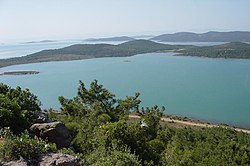Ayvalık Islands Nature Park: Difference between revisions
removed Category:Nature reserves in Turkey; added Category:Nature parks in Turkey using HotCat |
Rescuing 1 sources and tagging 0 as dead. #IABot (v1.2.5) |
||
| Line 54: | Line 54: | ||
==External links== |
==External links== |
||
* [http://wowturkey.com/forum/viewtopic.php?t=7243 Images of Cunda (Alibey) Island] |
* [http://wowturkey.com/forum/viewtopic.php?t=7243 Images of Cunda (Alibey) Island] |
||
* [http://www.ayvalikmedya.com Ayvalık Haber, Ayvalık Manzaraları] (Turkish) |
* [https://web.archive.org/web/20140304192207/http://www.ayvalikmedya.com/ Ayvalık Haber, Ayvalık Manzaraları] (Turkish) |
||
{{Aegean Sea}} |
{{Aegean Sea}} |
||
{{Nature parks of Turkey}} |
{{Nature parks of Turkey}} |
||
Revision as of 23:37, 22 October 2016


Ayvalık Islands are the group of islands around Ayvalık district of Turkey in Balıkesir Province in the Northeastern Aegean Sea. There are 22 islands and numerous rocks in the group, with Cunda Island, now a peninsula, being the largest. People live only on Cunda and Lale Islands. Cunda and Lale islands are linked to Ayvalık on the mainland, by a causeway enabling transportation by car. Cunda also has a ferry link from the main town, Alibey, to Ayvalık during the summer.
A Greek Orthodox metropolis was established, based in Cunda island, for some months in 1922.[1]
Wild life can be observed on the other islands, especially wild rabbits on Ilyosta Island. Also, those islands are the main points of interest to tourists as having small beaches and bays.
List of islands
Ayvalık Islands are also referred to as Yund Islands or Cunda Islands in some sources. The islands are called in Greek Εκατόνησα Hekatonisa which means "hundred islands", or Μοσχονησί Moschonisi i.e. "fragrant island", by the Greeks. The Greek name has different spellings of the former, such as 'Εκατόνήσος Hekatonesos, Εκατόνησοι Hekatonnesoi or Εκατός Hekatos, and yet another name exists altogether, i.e. Ἀπολλώνησος Apollonesos, the "isle of Apollo".
- Akoğlu Island / Kedi adası (Kopano)
- Cunda Island / Alibey Adası (Nesos=Ada, Mosko, Yunda, Moshonisi, Moshinos=Kokuluada)
- Çıplak Island (Chalkis, Cimno)
- Çiçek Island (Argistra, Angistri)
- Gizli kayalar Island / Secret Rocks (Petro=Rock)
- Göz Island
- Güvercin Island / Kızlar Manastırı Island / Madiens' Monastery Island (St. Giorgio / Aya Yorgi)
- Hasır Island (Sefiri)
- İkiz Kayalar Island / Twin Rocks (Daskali, Daskalio)
- İlyosta Büyük / Güneş / Fener / Grand Ilyosta Island (Ilyosta, Eleos=Güneş, Oilios)
- İlyosta Küçük / Yumurta /Little Ilyosta Island (Kilyosta, Eleos Pulo)
- Kalemli Island (Kalamaki)
- Kara Island / Balkan / Kutu (Kudho)
- Kara ada Island / Kamış adası / Akvaryum (Kalamo, Kalamos)
- Küçük Karaada Island
- Büyük Karaada Island / Balık adası / Tavşan (Psariano=Balık)
- Kayabaşı Island
- Kılavuz Island / Mosko / Pınar / Klavuz (Mosko Pulo)
- Kız Island (Ulya)
- Kumru Island
- Lale Island / Dolap / Soğan (Kromido)
- Büyük Maden Island / Maden (Pirgo, Pordoselene, Pirgos=kale)
- Küçük Maden Island
- Melina Island
- Mırmırcalar Island
- Pirgos kayalıkları (Rocks)
- Poyraz Island / İncirli / Yellice (Leyah)
- Sazlı Island / Oker
- Taş Island(Klavo)
- Taşlı Island
- Tavuk Island (St Yoannis)
- Tüzüner Island
- Yalnız Island
- Yelken Island
- Yuvarlak Island (Kalamo Pulo)
See also
References
- ^ Kiminas, Demetrius (2009). The Ecumenical Patriarchate. Wildside Press LLC. p. 69. ISBN 9781434458766.

